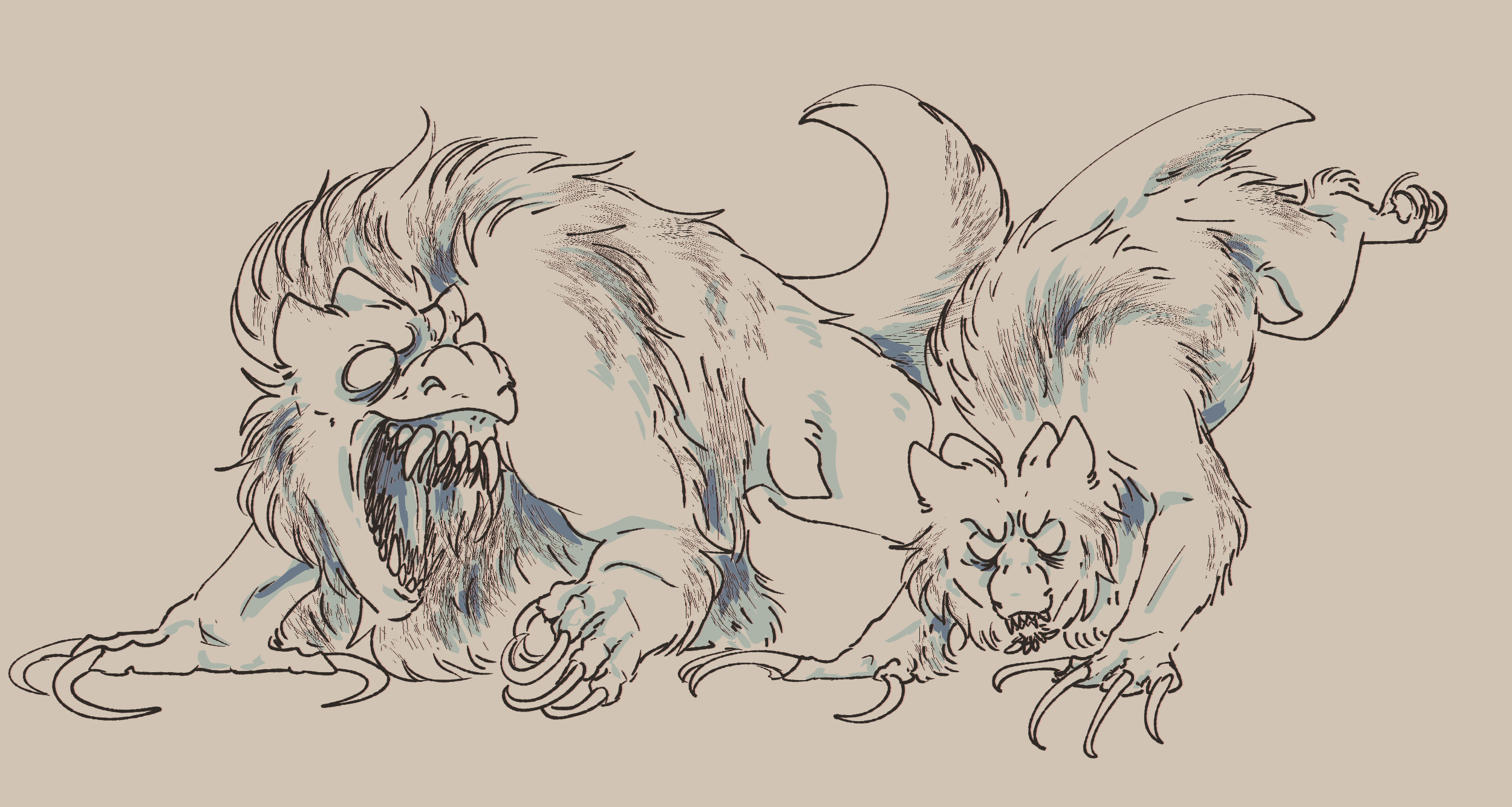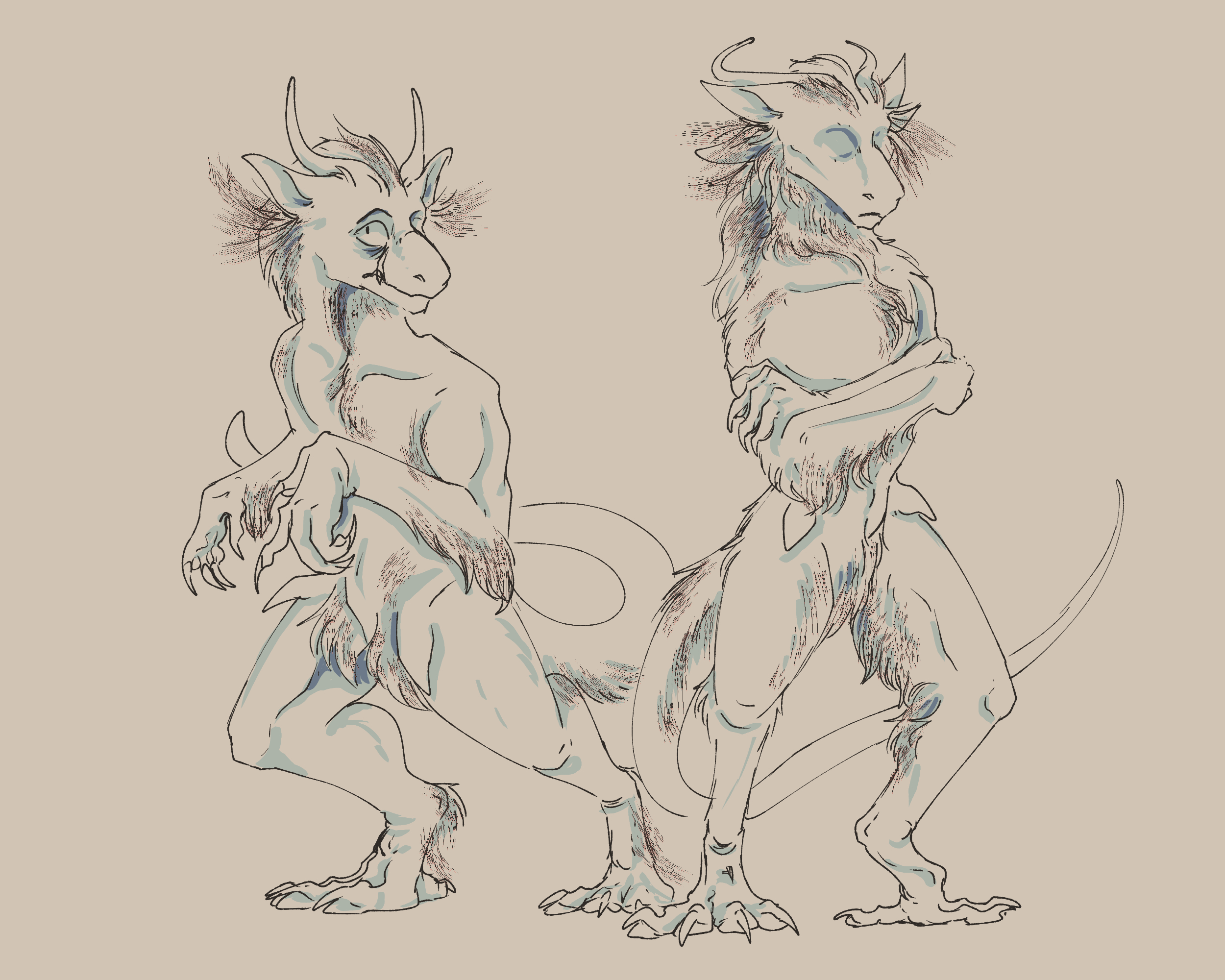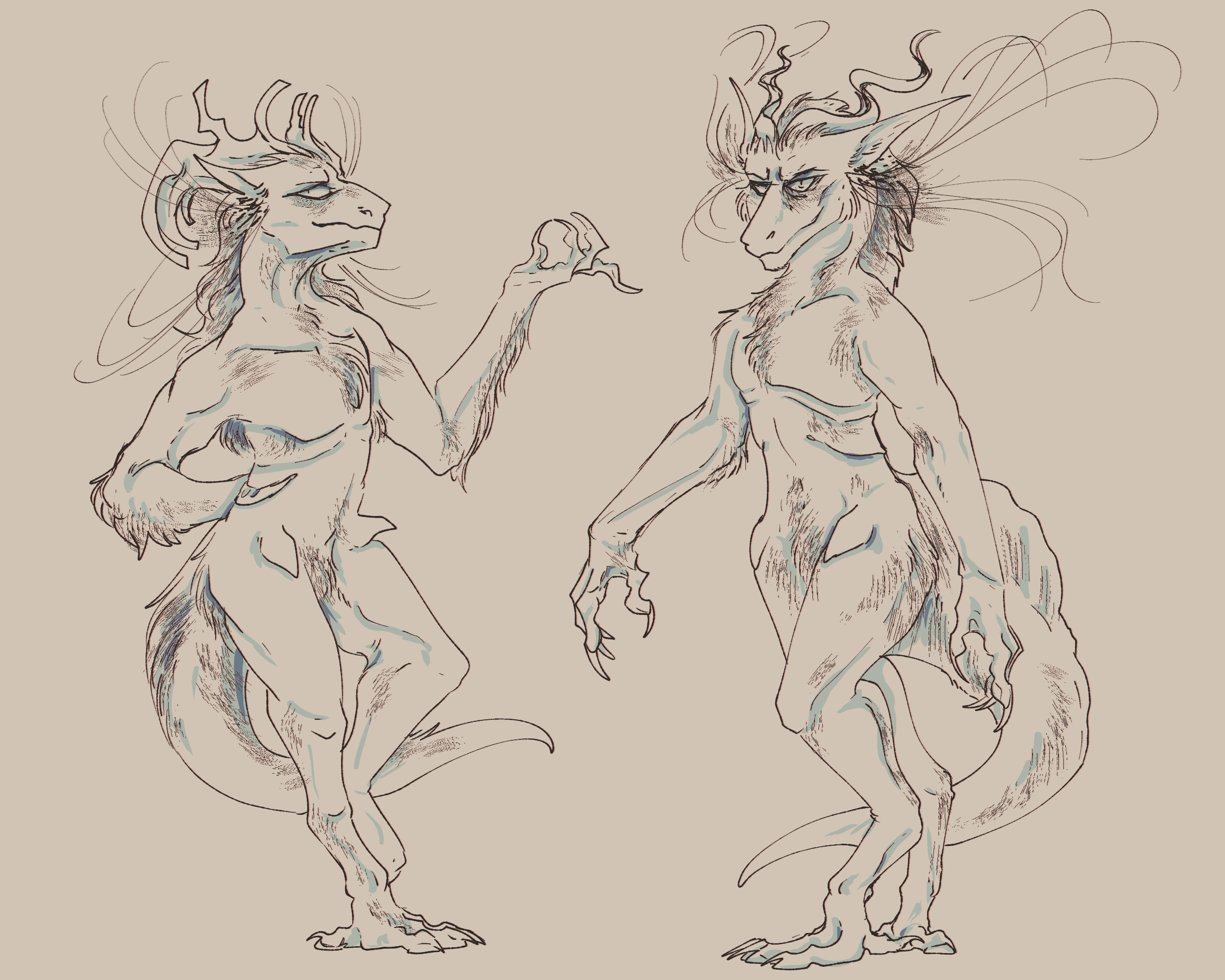Intelect and Nature
Dragomii are rather intelligent beings, when they slow down and focus that is. On average an individual would be considered decently smarter than humans, the gift of eternity is to thank
for that. Dragomii while sociable, intelligent, and agreeable. Are wild animals.Unlike humans these beasts have not domesticated themselves, they still possess every animalistic instinct and desire.
And being instinct-driven animals, they despite being fairly smart, will most often act first think later. Which has created their extremely durable bodies by way of evolution, as those unable to sit, concentrate, and think
often end up killing themselves by way of idiotic move.
Biting, clawing, snapping, hissing, barking, nesting, and growling are common standard behaviors. They will snap at each other and chase after small prey. Alongside spoken and signed word, dragomii like bees do
have complex and intricate dances and combos of movement that will quickly get across a complex message. The shaking of the head, swaying side to side, and other more complex and exaggerated movements are performed
to convey emotion and message. Dragomii often speak in sing-song tones of voice. As with a universal deep love and connection to culture and piety, it is only natural their spoken words are to take upon aspects of that. Which in most cases
express as speaking in song. Though topics that are serious or dire often do have individuals speaking normally, as to convey dire tone. This aspect of song interwoven into speech acts as more identifiers for tone and meaning.
Dragomii generally do not care for the bodies of the dead, this is in part due to their wild nature. And their extremely violent tendencies, for the reason they have so many context clues and expressive signs. To avoid fights, as dragomii
have a temper hotter than the deepest pits of hell, they can, do, and will kill if they feel challenged and if the other accepts their duel. As far as they are concerned, The Cycle will take the dead and march ever onward. As long
as one's temper is not tried and their boundaries not forced, and small nips and warning growls listened to. One should have little issue getting along with and agreeing with these beasts of a violent nature. They do not have anything hardwired
into them, as to produce torment upon killing another of their kind, and dragomii do encourage cultivated and careful violence. This general disregard for the dead sees them recycle the fallen into various tools and materials.
Alien Emotions
Dragomii are very emotional beings, being extreamly reactionary. Thus have emotions only they can understand.
Often do these alien emotions take over and drive them forth, wether that be to good or bad ends.
Alien things that only vague words can describe. They are as listed:
-
Cyacrafar
-The call of the void, as The Cycle and and its commander Existence call back.
A deepfelt need to climb that spire, a need of transcendent longing. Of transcendent exhaustance, solemn
and happy, the feeling of a skull cracking and a neck-snapping. A hollow pious chill to creep down their
back and encircle eyes.
-
Vincoverack
- An emotion that cannot be defied, it is one they all fight against lest the
alien semblance of rage and black bitter death mired in hollow insanity take hold. Drive them to be
nothing but a beast of rage, langar, sorrow, agony, and vengeance.
-
Langar
- The feeling of entrapment eternal of a void. A grey-brown place mired in fog of memory, memory clouded by older stranger desire. Yet solemnly out of reach,
a sweet and agonizing sort of thing. Yet with a deeper pain to manifest physically.
-
Kilhia
- An emotion of longing and fond memory, something of a happy recall.
Yet hollow lust and long simmer at its edges. Often driving one into a rage if felt for too long.
-
Brumar
- To challenge life's hellish fire, to smile in face of indignity. A stride, a pride, drunk with happy hellish mire.
To not be defied in soul, and in attempt of body.
-
Mithoul
- Cracked smile and happy saunter, for the dead so speak neither here nor there. Trapped they speak for the world yet do not hear their words, to smile and embrace that remembrance.
Sweetest story to be forgotten, details mired, yet memories remain.
-
Rotacal
- The emotion of the damned, of the pious, of the rotten. Where the sins of past writhe and crawl, burst into blood under skin. The rot consumes and it demands
exhaustance and bitter defiance embodies this alien thing.
-
Morolt
- A love deeper than one can handle, a bond shared by two. Something to kill the other if one dies, something to split maw and break jaw if mate shall fall. To cry
ranchor and to die. To intertwine and live as one, two beings of the same, emotion and hunger shared. Rage and hate ensnared.
-
Beseer
- Penitence of an unimaginable radial desire, a need, a fight, to rake the skin and tear the flesh. To consume the blood of their profane
and grotesque forms. To snap brittle bone and dig out eyes in service of thine lord.

Lack of Remorse
Dragomii are incapable of feeling remorse. They cannot, and will never feel for what they have done.
Unlike Sables who are very capable and feel remorse exceedingly strongly. The dragomii do not; this inability to feel
remorse does not equate them to unfeeling bastards. They can recognize an ill they have done, but they will not feel
for it. They can choose wether to better themselves, but they will feel if anything annoyance at the prospect. Many
despite this fact will still apologize, it is a acknowledgement of harm done. Apologies are not emotional, they act
simply as a device for understanding the other.
The closest one of their kind can come to remorse, is if one is domesticated. A exceedingly rare occurrence that is
solely happenstance. By way of a perfect accidental chain of breedings. Domesticated offspring usually
don't last long. Even then the degrees of remorse vary greatly, from twinges, to half the feeling. Unique to them as well is
the feeling of empathy.
Feeling of Guilt
Guilt is processed vastly different. For dragomii, they will not feel any twist of the heart,
nor pangs of pain. Guilt once more is a simple acknowledgement, a recognition of what was done.
And if anything is to be felt, more oft than not. It be a sort of persecution they feel, wether
they watch their tongue or lash out be up to the particular individual. This is not to say
they will act out of line without fear or restraint. They have a culture of respect and prestige, and if one is
to act so rash quick will they find themselves a trophy upon the wall.
Often, when their strange guilt is processed and acknowledged. The offending party will pay to settle a debt. Wether that
be the meaning of self, an item from their horde, or service is up to the offended. Dragomii pay for forgiveness, and even
then they may pay the toll to be rewarded nothing.
Domestication
Domestication is beyond rare, it is the perfect aligning of the stars. Subservience to sneak into a species so violent. The topic is wildly
debated, with many coming to agree that their domesticated kindred should not serve in government. Leaving those who feel, to feel even more
persecuted. This agreement had a probable cause, Queen Isenblaihk and the disaster that a domesticated individual faced in a world that
could not see through their eyes.
With domesticated dragomii a strange phenomenon occurs, the majority of domesticated individuals fail to
develope pupils in their later stage of life. Leaving them with partial blindness. Much like their distant Sable kind.
Not too much is known about the domesticated. Often are they too kind for a world so cruel, unaware the raving animal hungers at
the sight of outstretched fingers; blind to the bread offered.

























